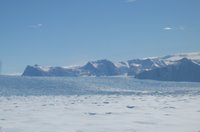Outflow from David and Reeves Glaciers
 Monday and Tuesday we flew to the mouth of the David and Reeves glaciers ( "south" of McMurdo in the map on the right). The long river of ice extending from the David glacier is the Drygalski Ice Tongue. Both flights were a success because most of the instruments worked and we measured increased levels of NO (nitric oxide) in the outflow of the
Monday and Tuesday we flew to the mouth of the David and Reeves glaciers ( "south" of McMurdo in the map on the right). The long river of ice extending from the David glacier is the Drygalski Ice Tongue. Both flights were a success because most of the instruments worked and we measured increased levels of NO (nitric oxide) in the outflow of the glaciers. Interestingly, the winds from the Reeves glacier were much stronger than over the Drygalski ice tongue, and the levels of NO were higher in the flow from the Reeves. On the way back from the glaciers we flew downwind from Mt. Erebus and also noted some higher levels of SO2 (sulfur dioxide). Lee Mauldin (an NCAR scientist on our team) took this picture on the right of the Drygalski ice tongue flying at 100 ft above the surface.
glaciers. Interestingly, the winds from the Reeves glacier were much stronger than over the Drygalski ice tongue, and the levels of NO were higher in the flow from the Reeves. On the way back from the glaciers we flew downwind from Mt. Erebus and also noted some higher levels of SO2 (sulfur dioxide). Lee Mauldin (an NCAR scientist on our team) took this picture on the right of the Drygalski ice tongue flying at 100 ft above the surface.
 After the flight, here is Marty Buhr downloading the NO data. Calibrations are a very important part of making measurements. Most of the instruments are calibrated in flight. Marty has a bottle of NO (with a known amount of NO in it) on the plane and every 10 minutes h
After the flight, here is Marty Buhr downloading the NO data. Calibrations are a very important part of making measurements. Most of the instruments are calibrated in flight. Marty has a bottle of NO (with a known amount of NO in it) on the plane and every 10 minutes h e samples from the NO cylinder to check that he is getting good measurements (at this time he also does a zero check as well, to look at the background counts). For my sunlight measurements (ultraviolet and visible), I do calibrations after each flight with a series of light bulbs. I have compared these light bulbs to calibrated lamps in the lab at NCAR. In Antarctica, I measure the
e samples from the NO cylinder to check that he is getting good measurements (at this time he also does a zero check as well, to look at the background counts). For my sunlight measurements (ultraviolet and visible), I do calibrations after each flight with a series of light bulbs. I have compared these light bulbs to calibrated lamps in the lab at NCAR. In Antarctica, I measure the  light from these bulbs for 5 minutes each to make sure the instrument is performing correctly. I also can check the alignment of the optics, but looking at some specific Hg (mercury) emission lines. Sometimes after a hard landing, I need to adjust the instrument alignment. Thus far the pilots have done a great job and I have had only minor changes in my calibrations. Here is photo of the calibration stand and the quartz light collection optic (the white hemispheric dome at the top). The calibration bulbs shine light through the hole in the center of the photo.
light from these bulbs for 5 minutes each to make sure the instrument is performing correctly. I also can check the alignment of the optics, but looking at some specific Hg (mercury) emission lines. Sometimes after a hard landing, I need to adjust the instrument alignment. Thus far the pilots have done a great job and I have had only minor changes in my calibrations. Here is photo of the calibration stand and the quartz light collection optic (the white hemispheric dome at the top). The calibration bulbs shine light through the hole in the center of the photo.

<< Home